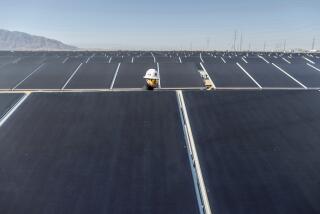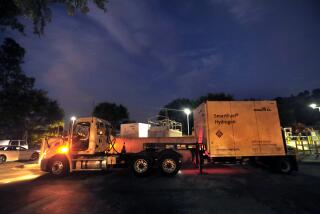‘Artificial leaf’ now ready to get dirty, inventor says
Harvard chemist Daniel Nocera recently developed the world’s first practical artificial leaf – a silicon-based device that could use sunlight to split water and create clean fuel. Now, the scientist says he’s improved the leaf – making it able to self-heal and to work even in dirty water.
Nocera discussed the advances this week at the American Chemical Society meeting in New Orleans.
The artificial leaf has been called a holy grail for decades, and scientists had been working on designing an efficient device that, like plants, can use sunlight to create energy. But where plants make sugars, scientists wanted to split water into clean-burning fuel.
Nocera’s device looks deceptively simple: It’s a catalyst-coated silicon wafer roughly the size of a credit card that can be dropped into a cup of water. When the wafer is placed in sunlight, pure oxygen will bubble up from one side and pure hydrogen from the other. Such a device, placed in a bucket (and with the two sides properly separated) could create enough clean fuel to power a home for a day in developing countries.
Nocera’s groundbreaking leaf came with some limitations: It had to be used in super-purified water; otherwise, bacteria would form a biofilm over the device, halting production. This would have proved to be a significant roadblock in making the technology economically accessible, given that many of the poor in developing countries don’t have access to clean drinking water, let alone ultra-pure water.
But now, he’s developed a cobalt-based coating that breaks off during the gas-producing reaction and then slowly reassembles back onto the silicon wafer. Because it’s constantly re-forming itself, the bacteria don’t have an unbroken surface to stick to – which makes the new and improved artificial leaf a more rough-and-ready device that can be deployed even in dirty water.
Such a device could radically revolutionize clean energy, reducing dependence on fossil fuels and providing an even better solution than plain old solar cells, which are perfect for sunny days but don’t store energy for nighttime use.
But there are limitations. While his energy-to-fuel system is currently around 70% to 80% efficient, Nocera said, it’s only as good as the silicon-based solar underlying it – and given that current solar cells have an efficiency rate of 7%, that means an overall rate of about 5% for his artificial leaf. But Nocera sees the new catalyst improving the performance of his device, and he expects solar cells in general to vastly improve over the next few years.
“At the end of the day I’m always tied to the efficiency of the [semiconductor] that I’m using,” Nocera said. “I can’t outrun that.”
And for hydrogen fuel to be useful, fuel cell technology would have to be far more prevalent than it is now, he pointed out.
Follow me on Twitter @aminawrite.







